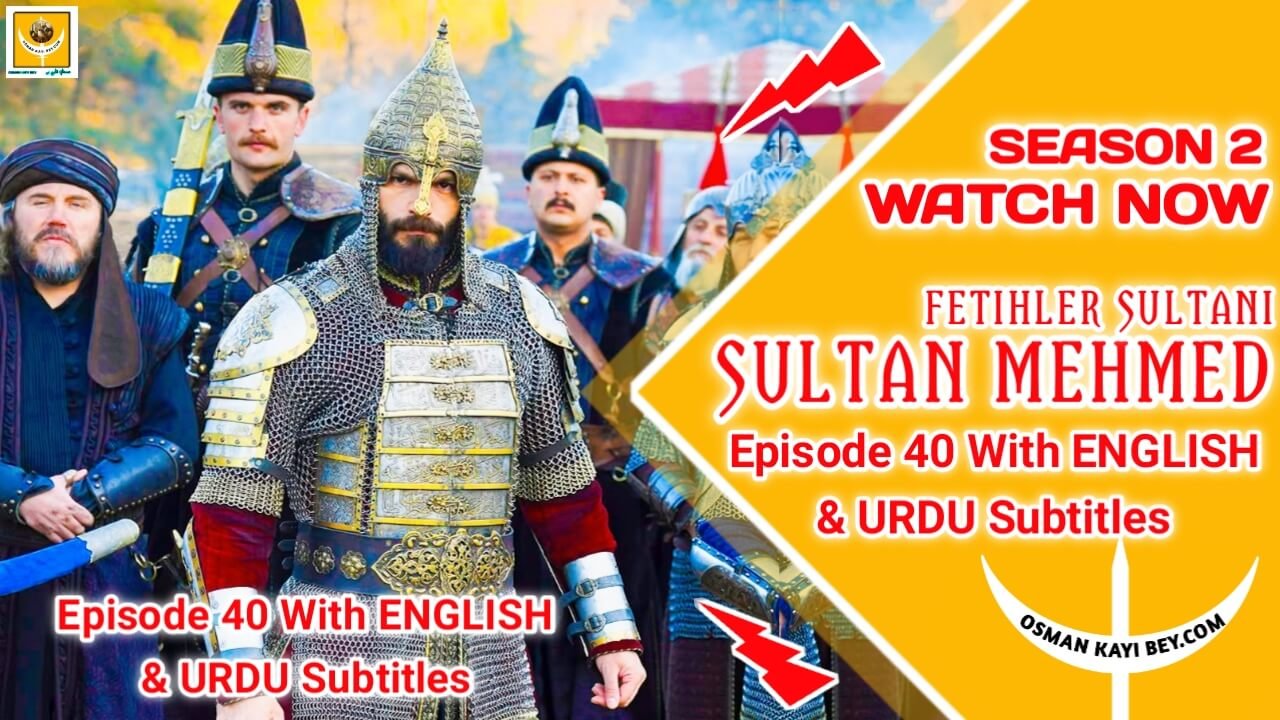Mehmed Fetihler Sultani Season 2 Episode 40
The Trial of Loyalty: Notaras Caught Between Shadows and Allegiance
In the intricate web of alliances and betrayals, Notaras emerges as a character of deep conflict. Though he has seemingly sworn loyalty to Sultan Mehmed, his past ties to the Byzantine elite and his unexpected rescue of Satilmis raise crucial questions. Is his transformation genuine or part of a deeper strategy? Sultan Mehmed senses the complexity of Notaras’ allegiance and prepares a subtle test—an unseen trial to measure the sincerity of this new ally. This quiet tension hints at a psychological war unfolding beneath the battlefield, one where deception could outweigh swordsmanship.
Mehmed Fetihler Sultani Season 2 Episode 40
Francesco’s Suspicion Sparks a Dangerous Hunt
As the Ottoman camp heals its wounds, Francesco’s mind spirals into vengeance and suspicion. The failed schemes and sudden shift in power dynamics lead him to believe that a traitor roams freely in his inner circle. His hunt for the mole becomes more personal than strategic. While others prepare for war, Francesco retreats into the shadows, where his vendetta brews silently. His every move now threatens to unmask those secretly aiding the Ottomans from within the fortress walls. The question isn’t whether he will find the traitor—but what he will do when he does.
Satilmis’ Recovery and the Faith of the Frontline
A seasoned warrior and a trusted blade, Satilmis Agha lies wounded, but his spirit remains unbroken. His recovery represents more than survival; it symbolizes the perseverance of the Ottoman frontline. For Sultan Mehmed, Satilmis is not just a soldier—he is a reminder that this conquest is built on the courage and blood of loyal companions. The camp awaits his return, and whispers of his potential recovery lift morale. Whether or not he stands again in battle, his name already stands immortal in the heart of the Ottoman army.
The Sword of Justice: Koko’s Execution and Its Symbolism
By publicly executing Koko with his own sword, Sultan Mehmed does not just serve justice—he establishes absolute authority. This bold act sends a chilling message across friend and foe alike: betrayal will not be tolerated. But this moment is also deeply symbolic. It marks a turning point where Mehmed shifts from the strategist behind plans to the warrior-leader on the frontline. His presence now commands more than respect—it instills fear and reverence. With one swift strike, the Sultan redefines leadership, merging justice with unwavering discipline.
The Whispering Streets of Constantinople
While the Ottoman camp buzzes with strategy, the streets of Constantinople whisper of fear. Citizens sense the coming storm, and rumors swirl of Notaras’ betrayal and the city’s internal collapse. These subtle currents of unrest become a silent ally to the Ottomans. As panic rises within, so does the chance of infiltration. Sultan Mehmed’s psychological warfare intensifies, using fear as an invisible arrow piercing the morale of his enemies. Every whisper, every rumor, becomes a weapon in his conquest.
Sultan Mehmed’s Declaration: The City or My Life
In one of the most stirring proclamations, Sultan Mehmed declares, “Either I shall take Constantinople, or Constantinople shall take me.” This isn’t mere rhetoric—it’s a vow carved into history. With this, Mehmed enters a state of total war, where retreat is no longer an option. His soldiers hear not just a command, but a covenant of destiny. This bold declaration turns an army into a movement, a campaign into a divine mission. The Sultan no longer chases victory—he embodies it.
Unseen Threats and the Fading Line Between Friend and Enemy
Even as the army marches closer to Constantinople, unseen threats multiply. The enemy doesn’t always wear armor or carry a sword. Some smile, some pretend to serve, while plotting betrayal in silence. Sultan Mehmed knows this well. His court is alert, his tests are quiet, and his punishments are swift. In this phase of the conquest, trust is rare, and vigilance is the sharpest weapon. The true war, it seems, is as much about loyalty as it is about land.
The Shadow War: Francesco vs. Notaras
A parallel war brews beneath the surface—Francesco versus Notaras. Both men serve opposite causes, yet both operate in secrecy. Their clash isn’t in open combat, but through silent moves, covert alliances, and hidden motives. Each tries to outwit the other, knowing that whoever gains the upper hand in this invisible battle could alter the fate of the actual siege. The war of shadows may determine who controls the fate of Constantinople even before the gates fall.
Anticipating the Final Push: Strategies and Sacrifices
Sultan Mehmed knows that with every step closer to Constantinople, the resistance will harden. He refines his plans, preparing for a final push that will either break the enemy or shatter his forces. His generals debate multiple routes, from the sea walls to siege towers. Yet behind every plan lies the quiet acceptance of sacrifice. Mehmed understands that conquest demands more than tactics—it demands martyrs. As soldiers write farewell letters, the air grows heavier with purpose.
The Calm Before the Storm: Silence Before Siege
The days before battle are filled with a haunting stillness. Camps prepare, weapons sharpen, prayers whispered. Even nature seems to hold its breath. This eerie calm foreshadows a storm that will rewrite history. Both sides know that this siege will not only test swords but will define the soul of empires. Sultan Mehmed, calm yet fierce, stands ready—not just to win a city, but to forge a new era.
Conclusion
Sultan Mehmed’s conquest of Constantinople isn’t just a military feat—it’s a layered tale of loyalty, betrayal, psychological warfare, and divine ambition. Each character, from Satilmis to Notaras, adds depth to this narrative of transformation. As the siege nears, alliances will be tested, secrets will surface, and destinies will be decided not only by swords but by the strength of purpose. The conquest is not only about taking a city—but about proving the resilience of faith, leadership, and vision.
Table: Key Conflicts and Turning Points
| Event | Impact | Key Characters |
|---|---|---|
| Koko’s Execution | Public show of justice | Sultan Mehmed |
| Satilmis’ Injury | Test of resilience | Satilmis Agha, Saltuk |
| Francesco’s Suspicion | Internal chaos | Francesco |
| Notaras’ Loyalty Test | Dual allegiances | Notaras, Mehmed |
| Final Push Planning | Battle strategies | Mehmed, Ottoman generals |
Key Takeaways
- Loyalty and betrayal drive much of the internal tension within both camps.
- Notaras’ role adds unpredictability to the alliance structure.
- Satilmis’ survival boosts morale but also symbolizes the pain of conquest.
- Mehmed’s declaration turns the siege into a spiritual mission.
- Francesco vs Notaras adds a thrilling shadow war narrative.
Frequently Asked Questions
To set a powerful example that betrayal will not be tolerated, and to establish absolute authority among his ranks.
His past affiliations and current position make him both an asset and a potential threat, testing the Sultan’s judgment.
While uncertain, his survival alone has galvanized the Ottoman spirits. His return would mark a symbolic victory in itself.
While uncertain, his survival alone has galvanized the Ottoman spirits. His return would mark a symbolic victory in itself.
His strategic mind and emotional intensity pose a deep internal threat to both Byzantines and any double agents.
All signs suggest that the final confrontation is imminent, with strategies finalized and morale at its peak.

